Theatorium, First Movie Theater in Milwaukee, Razed
The Milwaukee Journal, February 4, 1923
The Theatorium is but a memory. Perhaps few Milwaukeeans know the little motion picture house that did business near the northeast corner of Second Street and Grand Avenue. But back in the days when the film industry was in its infancy, the Theatorium was the most popular place in town.
The Theatorium, Milwaukee’s first movie house, is being torn down. There were other business firms in the same building. There was Adeline’s Eat shop and Kalt’s restaurant, Leo Abraham’s cigar store, Solomon’s jewelry store and Charles Fox’s haberdashery, but the Theatorium was the pioneer of them all.
Seventeen years ago, Thomas Saxe conceived the idea of running a Hales Touring Car. He fitted up the Theatorium as a railroad parlor car. The patrons sat on the observation platform and gazed at a sheet behind which a projecting machine of a crude sort was placed. The machine threw the reflections on the back of the sheet in those days, while a man with a hose stood by and dampened the sheet so that the pictures would show through. There was also a device operated by a lever, which caused the floor of the Theatorium to rock, thus making the patrons believe they were really viewing the landscape motion pictures from the rear of a moving train. There were 40 seats in this Hales Car, named after a railroad car, used for the same purpose, which toured the country. That was the first picture show of any kind in Milwaukee.
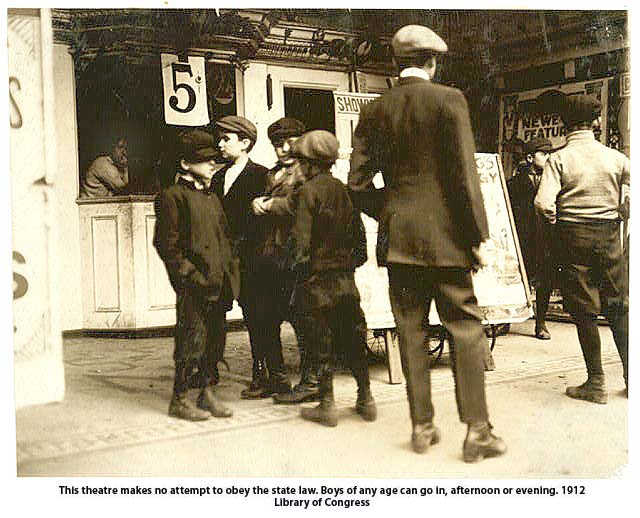
A little later, Mr. Saxe installed nickelodeon equipment. Then it was that many Milwaukee mothers missed their change and their children. When a child could not be found, searchers watched the doors of the nickelodeon, hoping that the lost one might make his appearance in that vicinity. Usually, he did.
E.M. (“Broncho Billy”) Anderson, a bold, bad, Wild West two-gun man, was the favorite of the time. Shows lasted 10 minutes and were run off as fast as the operator could grind. At that time, there were only four other theaters in the city: the Shubert, Alhambra, Bijou (now the Garrick), and the Pabst. Now there are 22, besides many neighborhood movies.
A big bank building costing $500,000 is to replace the old Curry Building in which the Theatorium was located. It will be four stories high. It is expected by officials of the American Exchange Bank that this building will be completed by May 1924.
The history of the Curry Building goes farther back than Theatorium days, however. In 1860, the ground was occupied by the old Spring Street church. This was torn down in 1872 to make way for the present building. It changed hands several times, but is now owned by Miss Martha Curry, from whom the American Exchange Bank obtained a 99-year lease. There is a frontage of 100 feet on Second Street and 65 feet on Grand Avenue.
Uptown Theater Opens in September
N.W. Side Men Plan Gala Day – August 27th, 1927
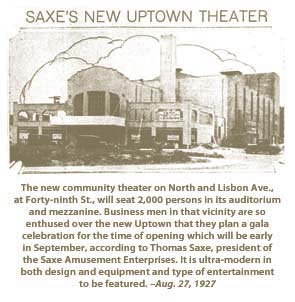
Northwest Side business professional and real estate men are taking a lively interest in the announcement that Saxe’s Uptown Theater, destined to be one of the most popular communities theatres in the country, will open early in September this week by Thomas Saxe, president of Saxe Amusement Enterprises. The Uptown, located on North and Lisbon at Forth-ninth Street, is ultra modern in both design, equipment and the type of entertainment that will be featured there. Designed by Rapp and Rapp of Chicago, world’s most famous theatre architects, it is Italian renaissance in motif and semi-atmospherical in its interior colorings and decorative effects. The Uptown will seat 2,000 in the comfortable auditorium and palatial mezzanine and will fill a long need in its particular vicinity with embraces of all on northwestern Milwaukee and Wauwatosa. Business men in these neighborhoods are so enthused over the Uptown and what it will mean to the true citifying of the district that they plan a gala celebration at the time of opening. Mr. Saxe states that complete details regarding the definite date, type of entertainment to be offered and other exciting details will be announced next week.” Wisconsin News, Saturday, August 27th, 1927.
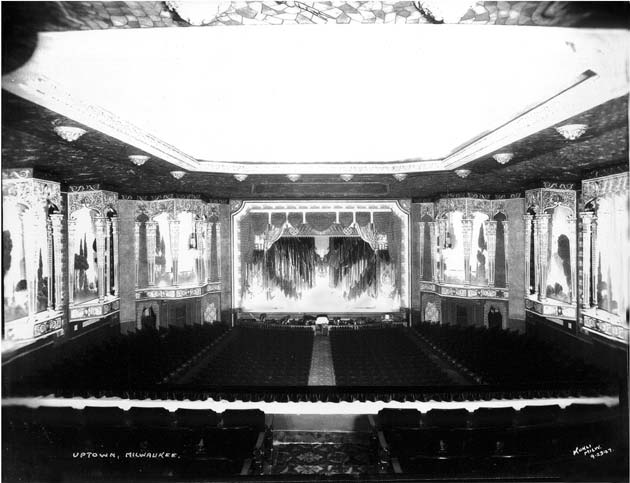
The Uptown, 2323 N. 49th Street, was one of a series of six movie palaces that the Saxe brothers, Tom and John Saxe built in Milwaukee the late 1920s. (The only one left is the Oriental Theatre) The design of the Uptown Theatre was Hollywood’s idea of a Roman villa. The triple windows in the front of the theatre had beautiful drapes visible from the outside hung in a display above the ticket lobby. The backlit marquee had 18-inch UPTOWN letters on the front & sides that lit up red at night.
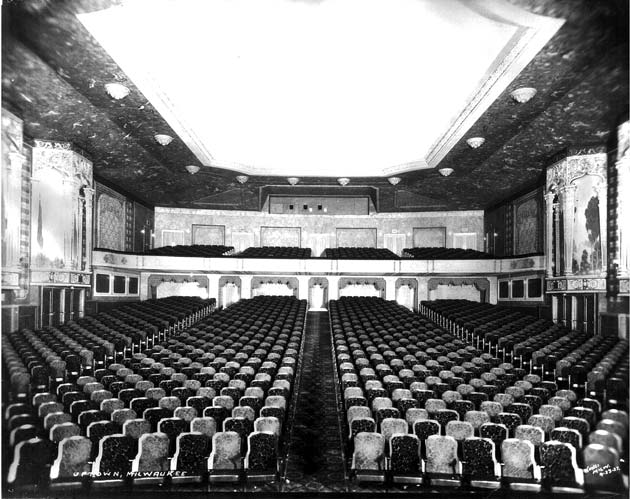
Like most theatres, the architects used a mixed style with the lobby having a very different look than the auditorium. Immediately inside the front entrance, there was a three-sheet ornamental cast iron lobby box for posters on each side. The large posters came in sections put together to make one large poster – 40 x 80 inches. The lobby was long and narrow – art deco. As you might have guessed from the photo of the front of the theater, the lobby was over two stories high with a vaulted ceiling and huge frosted glass art deco chandeliers. The center of the lobby had an eight-sided fountain. A boy with an umbrella spouted water in the middle. The walls of the fountain were covered with blue glazed ceramic tiles. The tiles were also used to outline the walls. The foyer had a 15-foot-long candy and soda counter.
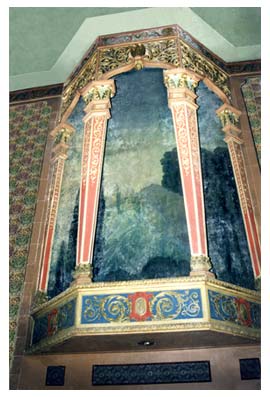
The side walls of the auditorium each had three faux balconies. Each has four columns running from the “balcony” to the ceiling. Each was over 25 feet high, 10 feet wide and six feet deep. The back of each “balcony” was covered with a canvass painting of an Italian landscape. The canvas was lighted from the inside base of the “balcony.” The “balconies” beyond serving as decoration served to control sound reverberations. The canvas being soft holds the sound wave preventing sound from bouncing off the side wall hitting the sound coming from the front. The tops of the columns met a cornice that corresponded to the bottom of the “balcony.” The cornice had three lights (red, blue, yellow) that went on with the house lights. At each side of the very front of the auditorium, a similar faux balcony had the organ pipes behind a panel with a screen. The theater had a 3/10 (three-manual, ten-rank) Barton theatre pipe organ – not exactly top of the line of theatre pipe organs. The console was ivory with gilt rococo mountings. In front of the organ screens hung art deco chandeliers with frosted glass sheaths with a bottom bowl of crystal strands to match the lobby. They were later removed when new air conditioning came in. The additional airflow caused the chandeliers to rattle – not good. They ended up hanging in a farmer’s barn. The original photos lack the detail in the ceiling around the dome. It originally was stenciled with a design of flowers and birds in hues of blues and browns. Later, the stenciling was painted over. The large rectangular dome covered most of the ceiling. All around the perimeter of the dome in a cove the house lights were placed. They were the main source of lighting for the auditorium. To get to the dome lights, you had to go up to the projection booth. From there you went to the air handler room, which also had the motor generators. The motor generator converted AC to DC current used for the two projectors and travel spotlight – 50V, 100 amp. Next you went up a short flight of stairs. At the top was a door leading to the catwalks above the ceiling of the auditorium. Catwalks from hell are a good description – no safety here. They were made of two parallel 2x12s hung on rods from the roof (about fifteen feet above). They had a 2×4 about a foot off of the planks for a railing. The catwalks ran down each side of the dome going all the way to the stage. To change a dome light you had to reach over the edge, and remove the colored lens. It was a slow process as the next step down was through the ceiling straight down. You always took along some extra lens in case you dropped one. The house lights were controlled from the projection booth.
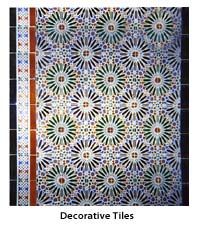

If you look at the front of the stage, the Uptown had a large orchestra pit. At the opening of a movie, it would have been full. The orchestra and pipe organ would have played a score to go with the movie. Silent movies were anything but silent. The main front drapes corresponded to the front of the proscenium arch. Behind the main drapes there was a good-sized stage perfect for live performance. The stage had trap doors and a counterweight system to lift sets and lights for stage shows. The screen was at the back of the stage. A second curtain was used to cover the screen during shows.
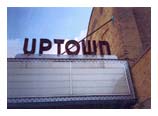
The small screen (television) was originally laughed at by the film industry. It took its toll with audiences dropping. United Artists tried just about everything to keep it going. A live performance was to become part of the Uptown’ legacy. Bruce Springsteen’s 1975 show at the Uptown Theater still is talked about. He was just starting to hit national attention. “I’m not sure whether it’s a tribute to the audience or Springsteen, but during that song (‘Thunder Road,’ with Springsteen on piano) there was perfect silence. Springsteen reached the audience like no other performer here has.” (Milwaukee Sentinel, Oct 3, 1975) Forty-five minutes after the show started, some one called claiming that a bomb had been planted at the Uptown leading to a rather quick evacuation. The search turned up zip in explosives with the show finishing.
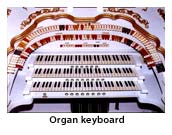
When the Uptown closed in 1980, the theatre was in pretty good shape. A maintenance man opened the cold water feed to the red-hot boiler (which had gone dry). The resulting steam explosion blew the boiler flooding the theater up to the fourth row of seats. United Artists gave up on the building. With no heat and a leaky roof much of the plaster from the dome dropped onto the chairs.
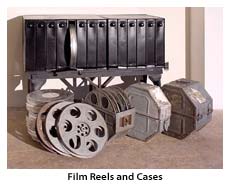
Editors note: Grateful acknowledge is given to Jim Rankin, theatre historian, who greatly impacted this article. I’ve checked with a number of other people who were involved with the Uptown. Paul Dorbialski was a projectionist at the Uptown. The projectionist union was one of the hardest to get into – very strong union. Running a projection booth required lots of skill. But that’s another story. Another source of information was Paul Finger. Paul had the salvage contract just the Uptown came down. Paul had to rent scaffolding to get the chandeliers down in the lobby. He helped us to save some of the equipment from the Uptown. Henry Weiland (Peters, Weiland & Company) is the reference for movie theatre organs. He does not like Barton organs (compared to Wurlitzer Theatre Organs).
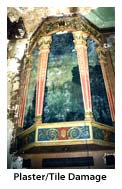
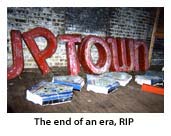
We wanted to save a stage light at the front of the catwalks right above the stage. Only one little problem – the cat walk had dry rot half way down due to water damage. Paul held the flash light as I jumped onto the air condition duct – quite large hung on rods from the ceiling. We walked down about fifteen feet and jumped back. Coming back with the light under one arm was another story. I need a good clean hit – too much or too little and it was one long drop after going through the ceiling. I remember saying “bring me home God.” Off I flew back to the catwalks.
Saxe’s Wisconsin Theatre (1924 – 1986)
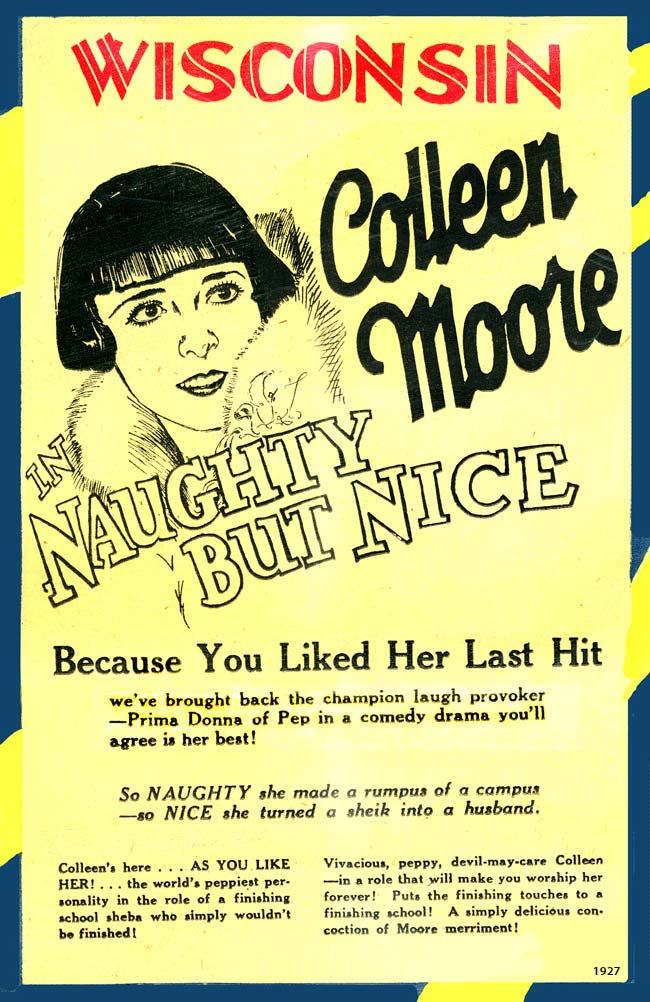
Neither rain and sleet above nor slush below dampened the enthusiasm of the 1,000 uniformed marchers and the 3,500-odd citizens who gathered to pay homage to Milwaukee’s newest monument to civic progress, the new Wisconsin theater, Friday night.
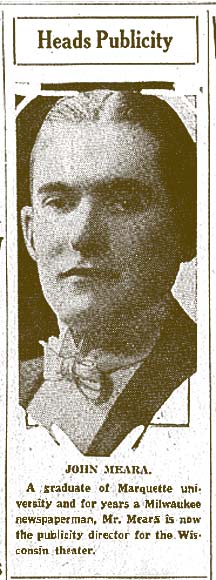
A full half-hour before the time set for the opening number on the program, every seat in the house was filled and hundreds stood in a mass formation before the Grand Avenue entrance waiting a chance to use their admissions and to view the magnificent show place of the northwest.
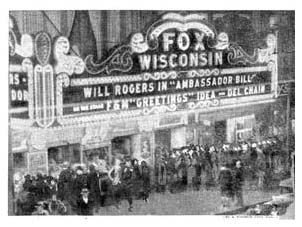
Many features combine to make the theater worthy of all the praise which has gone before it including deep carpets in a red tone and soft-cushioned seats for comfort which work together to make the theater an object of pride and satisfaction to all who attend it.” The Milwaukee Journal, March 29, 1924
Saxe’s Wisconsin was the largest theatre built in the state, seating 3,275 patrons. Built by architects Rapp & Rapp of Chicago, with the direction of Charles Brewster, this theater was located in the six-story Carpenter Building at 6th St. and Wisconsin Avenue. It opened March 28th of 1924 with long lines extending outside the theatre waiting to get in. Note the elaborate original marquee, which was typical of the era.
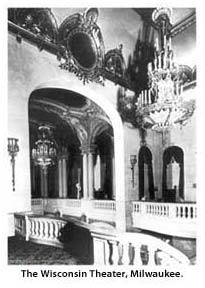
The lobby was white marble with a split grand staircase carpeted in green, which lead to the mezzanine and balcony. The lobby had oil paintings and statuary serving as a place for people to wait to get into the auditorium for the next show. Three huge chandeliers lit the lobby with smaller chandeliers along the mezzanine promenade. Once inside the French Baroque auditorium a recessed orchestra pit extended out into the seating area and under the stage beyond the line of the gold gilt proscenium arch. The design allowed for a much larger orchestra. In addition it had two organ consoles both used to play the 3/17-rank Barton theatre pipe organ. At an opening of a movie there would have been with a full orchestra plus the organ following a score that came with the silent film.
Here I need to digress a bit to explain the difference between a theatre pipe organ and a church pipe organ. The theatre pipe organs had all sorts of special sound effects that they could generate – tuba, xylophones, strings, glockenspiel, orchestral bells, chimes, harp, cymbal, sleigh bell, electronic brush, and locomotive bell. In addition they also could mimic the sounds of the trumpet, oboe horn, saxophone, clarinet, flute, tambourine and castanets. Next it could generate the sound of wood block, snare drum, base drum and kettledrum. For special effects the organ could duplicate a bird whistle or a steamboat whistle. The pipe used to create a bird whistle was half filled with water. As the air went through the pipe it “gurgled” creating the chirping bird whistle sound. Open up the rank and it really could get the low rumble of thunder.
The wood block sound from the organ would have been used during a cowboy movie. The hero was furiously riding his horse pursued by banditos. Five minutes later Tom Mix had shot all the bad guys and was kissing the girl (or his horse). The clippety-clop of the beating hoofs came from the wood block. The sounds of the gunshots are a theatre technique. When we snap a wood block clapper together behind the curtain it really does sound like a gunshot. Throw in the orchestra and any concept of a silent movie was gone. The reason that the old movie palaces worked so well had much to do with the theaters design for sound. Plaster has an entirely different sound reverberation than sheet rock used today. The last draw of the plaster was over a sheet of cloth holding the sound waves. You could sit in the 50th row of a theatre and talk in a normal voice to some one on stage. Architects knew how to build a theatre to accomplish this.
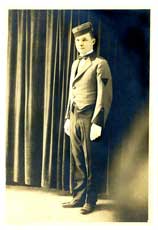
The theatre used air-cooling that pre-dated today’s air-conditioning systems. Under the seats, the air handlers pushed the air return over massive banks of pipes running cold water. It was a complicated expensive system to operate. One of the noted features at the theatre was the highly trained usher and the building took a large crew of them to operate.
Screens used for silent movies were smaller then. The original projectors used a low intensity Peerless Carbon Arc as a light source in the lamp house. The lamp house did not originally have a mirror at the back. The projectors were unusually long because the carbon arc lamp was located at the rear in order to keep the heat away from the nitrocellulose film, which was highly flammable and potentially explosive. The projection booth walls had a four-hour asbestos pyro-block structure for fire safety. The projection booth had small windows opening to the theater through which they projected the image onto the screen. In the event of a fire, a fuse link melted, dropping a plate over the window opening. With the advent of color film, it was necessary to switch to a Peerless High intensity lamp house. The original Peerless did not have enough lumens to project color. The Wisconsin Theatre would later switch to Xenon lamp houses with 70 mm projectors, then running on a much larger screen.
Typical of the times, the theatre ran both shows and movies. The Four Ink Spots was one of many nationally known artists to appear on the stage of the Wisconsin theater. Harry Holloway headed up the Milwaukee Sentinel Talent Quest as one of the stage shows.
The Wisconsin Theater was housed in the Carpenter building, which had a large roof top dance hall. It could handle a thousand people doing the Texas Tommy, Foxtrot, Animal Dances, Waltz, Tango, and Maxixe. In the summer, you could dance the night away in the open air for a dime. The large French Baroque bandstand on the roof could handle an orchestra of 25 to 30 musicians. Young people could go there to mix and meet, join the dancing and perhaps succumb to cupid’s arrow. A large neon sign on the roof was visible from the street spelling out “Roof Dancing.” For years after the roof was closed a large painted sign with the words DANCING – WISCONSIN ROOF was still visible on the east side of the building.
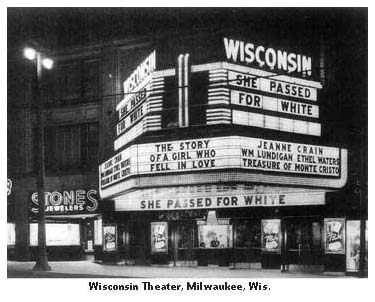
Movie theatres were constantly under pressure to upgrade in order keep customers coming in the door. By the 1940s, all traces of the Wisconsin’s “gingerbread” (elaborate exteriors) were gone. The era of orchestras and pipe organs were over – trashed. By the 1960s the Wisconsin theater was rapidly heading into death throes – while the city population too was rapidly dropping. The freeways that were supposed to have brought people into the city, instead moved them out. In 1963 the theater tried to change to stay in business. The theater was split into two theaters (Wisconsin Cinemas I & II) with a new modern marquee. Out went the chandeliers in the lobby. A double escalator went up four stories through the ceiling into the balcony foyer. The gold leaf was spray painted over to a tan color. Remember this rule: “To the child black and white is old and old is bad.” They were looking for a sleek new modern look. A new stainless steel concession stand was added in the lobby. Popcorn, soda, snacks are now the driving forces keeping theaters alive. The update worked to some limited effect, while running 70mm movies in the main lower theatre. By this time the rules had shifted with most of the ticket sale revenue going to the studios. By 1986 it was over. One of the large alabaster statues from the theater ended up a
Editors note: Part of the information on the Barton 3/17 organ came from an article on the Patio Theatre’s Barton 3/17 www.catoe.org/patio.html
The Warner Theater
212 W. Wisconsin Avenue, Milwaukee, WI, U.S.A.
by Jim Rankin
When the memorable Butterfly Theatre of 1911 was demolished in 1930 along with two other buildings, it was to make way for what would become the fanciest theatre in Milwaukee and one of the most beautiful in the nation.
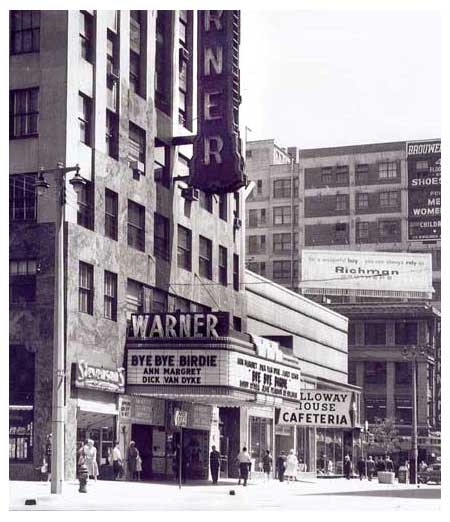
The Warner Brothers chain was looking for a first class opening in the city and spent $2.5 million to build this 2,400 seater. It is part of a 12-story office building veneered in marble and bronze spandrels and ornamented throughout in monel silver metal in Art Deco design. The lobby is a three story high dazzler in towering etched mirrors that were framed in deep maroon draperies with fringless tassels (drops) in silver silk and fringe.
An overview from the balcony grande staircase landing originally held a baby grand and a duet of violins to entertain the waiting throng on the patterned terrazzo floor below (fully carpeted not long after opening). This almost pure Art Deco space is illuminated by two giant chandeliers of concentric sheaths of etched glass, with matching five-foot-tall sconces on the marbled piers under the silver-leafed plaster of the geometrically molded ceiling.
On entering the auditorium one sees a vista in Louis XIV garnished with some lines and details from the Art Deco French. This room is not the reserved silver and maroon of the lobby, but an exuberant gold and wine with accents in antique verde and teal. Both side walls have three murals “after Fragonard” with scenes of courtly capers and above each is a gilded sunburst patterned grille back lighted by hidden cove lights above, in three colors.
Carrying the eye downward, the flanking organ screens are unusual in being free-standing arches within an arched bay that is also topped with another lighted grille, and the back of the archway is covered in draped velvets and a glittered scrim adorned with jeweled star shapes in aluminum.
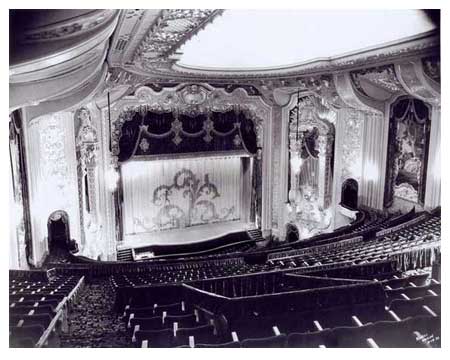
Centering the bottom of the arch is a five-foot tall golden amphora on pedestal with a back lit stained glass mural on its front of the Muses at play. Just as the top rear of the archway is graced with a stylized sunburst (Louis the XIV was the ‘Sun King’ and the sunburst motif was a signature of architects Rapp & Rapp) in gold leafed stylized rays, the chandeliers fronting the screens are also a stylized sunburst with etched glass ‘rays’ bejeweled with stained glass roundels, even though the wall sconces were hybrid designs having etched glass panels fronted by chains of glass beads with pendeloques.
The proscenium arch took up that entire wall, but the rectangular arch was relieved by clever enrichments in a central cartouche flanked by cornucopias and volutes and even a mask or two to break up the gilded lines. Half the arch was filled by the enormous Grand Drapery, a combination of five swags of maroon velour fringed in gold upon a lambrequin of crushed honey velvet, the whole adorned with four, eight-foot-tall pendants of padded silver silk fronted with a pattern of small squares of mirrors set into tiny brass frames, and this in addition to 15, 2-foot-long tassels and 18 similar fringeless drops of three molds each.
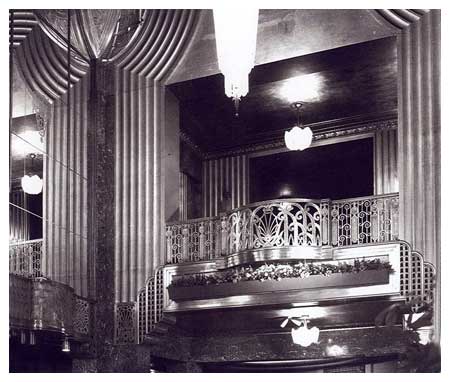
When the grilled dome above and the proscenium cove lights turned on with the footlights, this all took on a wonderful glow, as the 3 manual, 28 rank Kimball theatre pipe organ rose upon its lift to begin the overture. With only an 18-foot-deep stage, the theater was not really designed for stage shows, but mostly for film.
The blueprints show that provision was made for a motorized orchestra pit elevator, but along with other amenities, it was omitted as a cost conservation as the Great Depression made itself felt.
They did find money, however, for a display fountain in the basement lounge as well as on the next three levels above. The foregoing is a description of the former Warner at opening and is not entirely reflective of the state of affairs as of 2002.
The organ is now in Milwaukee’s Oriental Theater ever since the former Warner was split in two in 1973 and became the Centre Cinemas, and in 1982 was renamed the Grand Cinemas (in honor of the Grand Avenue Mall then opening across the street) until it closed in 1995.
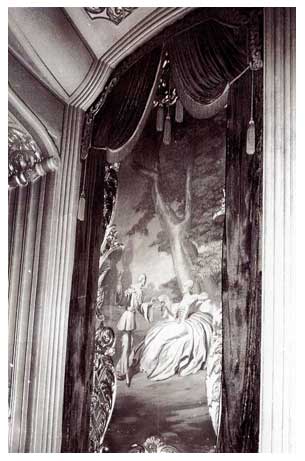
We can only hope that the Symphony buys it for their secondary concert hall (their primary venue being the Marcus Performing Arts Center), but what the unfortunate adaptations to their needs might do to this venerable showpiece showplace, we can only wait and see. Let us hope that they and their money backers will like grand theater architecture as much as grand music, for plans have been drawn by the current owner to demolish it if the Symphony declines.
Acoustic tests have declared the undivided theater to be excellent, and the Symphony is encouraged, but the price tag of renovations, and probably some form of parking structure next door could be as much as $50 million, a steep price for a regional orchestra, even though the community did find $100 million to open its art center this year.
If it is saved, we hope for a sympathetic treatment for this, probably the finest of Rapp & Rapp’s medium scale works.
Thoughts on the Warner Theatre
by Jim Searles
Under the Warner Theatre’s lobby there is a 100 seat viewing room. It was used for previews to determine film distribution.
Near the end of its life, a water main burst flooding the theatre up to the first floor. That happened when they turned off the heat in the building to save money. By the time a crew arrived to shut off the water, the damage was extensive. The electrical service rooms flooded. The master electrical breakers inside the city’s power vault under the sidewalk behind the stage (another reason it is difficult to extend the stage with only modest expense) blew open cutting off most of the theatre’s power.
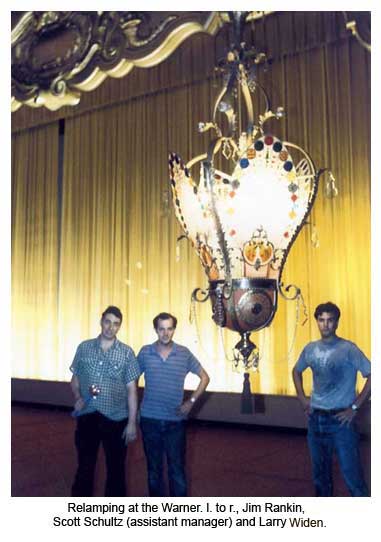
The office building above the theater was not affected. None of the auditorium and projection room lights worked and the African zebrawood and mahogany paneling of the basement lounge was badly warped. Needless to say, all paint, gilt and much of the ornamental plaster on that level was ruined, and the major restrooms down there were not accessible. The dividing floor of 1973 that created the Centre I & II Theatres had been removed. The open space from the alteration now would be easy to repair. The entire balcony front below the first crossover aisle was removed in those days, so that concrete and steel, as well as the original ornamental plaster front with its dozen spotlight holes had to be rebuilt and reseated. When the dividing floor was installed, steel beams were thrust through the proscenium arch to connect to the steel columns inside the back stage wall, and this makes the staging equipment unusable.
The ornate organ screens were completely removed and now are only black acoustic material plainly nailed to a wooden superstructure over the old swell shutter holes; this must be restored somehow, even though the then wonderful 28-rank Kimball organ was removed and reinstalled in the ORIENTAL Theatre long ago (1973). Reportedly, the projection equipment had been removed and sold, limiting the theater’s use. Gone also was the movie screen and the draperies.
The city steam equipment was now only partially working, and just barely kept the place above freezing in our sometimes sub-zero climate. There was some damage to the murals due to mildew, and some water damage from rain leaks.
For what it’s worth, the Milwaukee Symphony paid Altec for sound testing in the building. The Symphony’s acoustics consultant said it is excellent acoustically and far better than the PAC. —Adapted from an article originally written by Jim Rankin
The Butterfly Theatre
212 W. Wisconsin Avenue, Milwaukee, WI, U.S.A.
by Jim Rankin
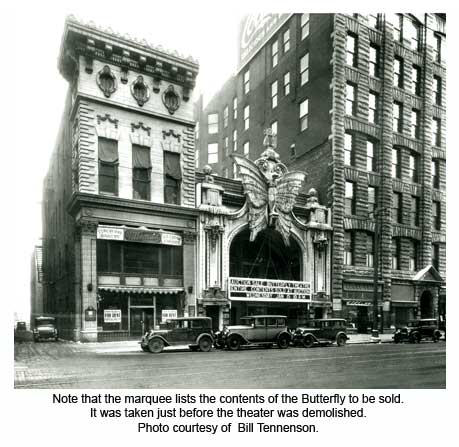
Of the 160 some structures used to show movies in Milwaukee prior to 1950, one among them became known nationally and was truly unique: THE BUTTERFLY. No doubt the name of this show house was chosen because of the design of a terra cotta butterfly for the facade, delineated in 1,000 light bulbs and spanning some 27 feet from wingtip to wingtip, which may have been seen in the Decorators Supply Co.’s catalog. This dramatic creation would certainly have taken Milwaukee and most the rest of the nation by surprise, for it so identified the theater with that 60-foot-high facade that no name sign was ever required. The butterfly with wings outstretched, had a body of a woman depicted draped in a Grecian gown, and atop the butterfly at the apex of the facade were volutes that supported a pedestal surmounted by a lyre, all delineated in light bulbs to bring the total upon the whole ornate facade to 3,000.
Why such extravagance in a 1,200-seat movie house opening on Sept. 2, 1911? Because it was the bellwether of the end of the era of the Nickelodeon theaters, and the start of the era of the ‘Photoplay Parlors’ then coming on the scene. If, as Shakespeare said, “The play’s the thing!” then theaters across the United States proclaimed ‘The facade’s the thing!’ on all their fronts as the twentieth century entered its second decade. We all put on a ‘good face’ to impress someone and exhibitors of photoplays (as multi-reel movies were known early on) were shrewd to realize this need for ostentation to attract attention away from their competitors and also entice the passerby to enter their ‘dreamlands’ of escapism.
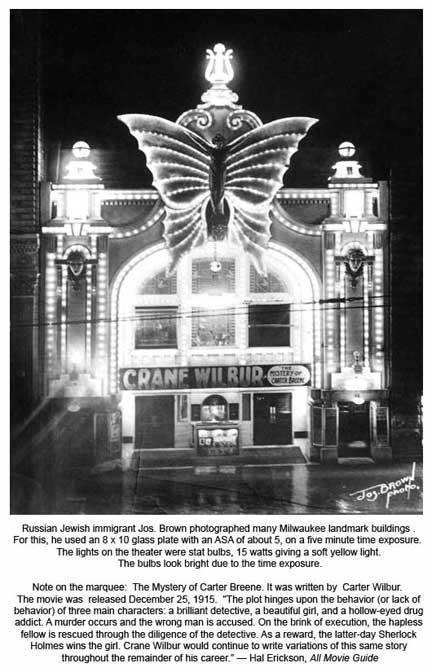
It would be nice to be able to thank local architect August Willmanns for this unique artistry, but it would have been extremely unlikely for him and his clients to have the funds to make the hundreds of molds for the terra cotta pieces that went to make up the facade. Companies such as Decorators Supply (still in business in Chicago) sprang up across the US and offered ready-made facades and interiors of plaster, composition, and terra cotta for those who could afford such elaborate luxury. Other firms specialized in pressed tin (metal) panels and borders to cover the interior of any wood frame building (as by the Milwaukee Corrugating Co., which sold “Invisible Joint Metal Ceilings” (and walls) to theaters nationwide). No doubt it was from just such a source that the architect selected the distinctive facade, and apparently no other theatre in the nation opted for this graceful design. This meant that he merely had to place an order for the thousands of castings needed from the stock at hand. Since there were several prominent terra cotta manufacturers in the Chicago area, and labor to make and glaze and fire such castings was then cheaper than the materials, it was a bargain for the architect, yet no doubt accounted for most of the reported $200,000 cost of the building.
The Butterfly was erected on the same site as owner Otto Meister’s Nickelodeon Theatre and Phanta-Phone dime museum of 1898 at 212-214 W. Wisconsin Ave., then called Grand Ave. He and veteran Milwaukee movies distributor John Freuler bought the land and formed the Central Amusements Co. to construct and lease the theater.
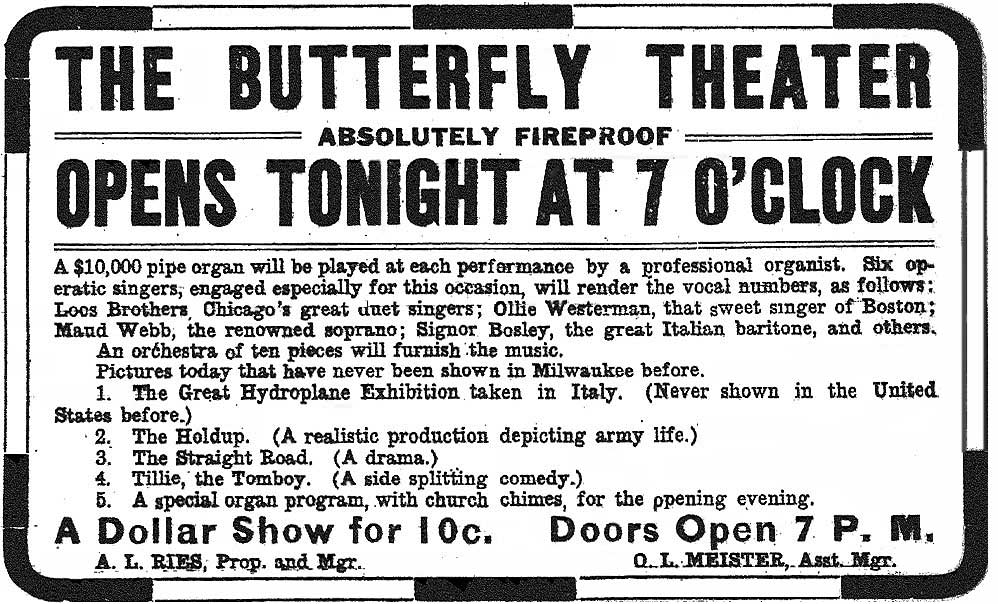
The Butterfly opened to great acclaim what with its dazzling facade, a lobby with a marble floor and gilded bird cages of canaries to greet the throngs, and an ivory and gilt auditorium draped in crimson and burgundy and lit with crystal chandeliers. The seating was on two levels with 292 seated in the balcony with a mirrored staircase from the lobby. The theater boasted a 10-piece house orchestra, a $10,000 pipe organ of unknown make, and six classically trained opera singers. This venue was to be ‘class’ all the way.
They didn’t stop at the decorations and music, for the place also proclaimed that it had the most advanced ventilation system capable of changing the air every three minutes (nickelodeons were often known for their pungent atmospheres as a result of no ventilation) and that the whole building was fireproof – this at a time when the public’s memory of gas lit theaters bursting into flame was all too fresh.
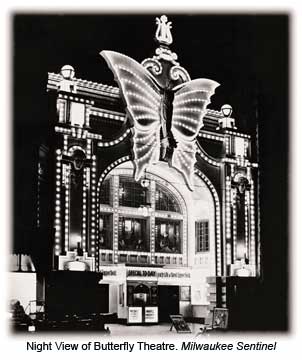
While it is true that Milwaukee’s PABST and ALHAMBRA legitimate theaters were well known nationally, the Butterfly was among the first Photoplay Parlors to make photo postcards available, and images of that dazzling facade at night were spread across the country. So widespread were these cards that two national books (besides “Milwaukee Movie Palaces” by Larry Widen), feature large photo reproductions of that very postal card: “Nickelodeon Theatres And Their Music” from East Coast author Q. David Bowers, and “Tickets To Paradise: American Movie Theatres And How We Had Fun” from West Coast author John Margolies. The Butterfly rightly was featured as a prime example of the glamour and ballyhoo so common to that era.
That was a short era for the Butterfly because in only 20 years another acme in the design of theatres occurred on that same spot in May, 1931 when the WARNER movie palace opened. The Central Amusement Co. made a small fortune selling that land to the Warner Bros. theaters and that firm also then bought and demolished two other buildings to make room for their 2,400-seat masterpiece, which was last called the GRAND (Warner). In 1930 the butterfly came down, but at least it was not due to failing attendance, as is so common to what old theaters remain today, but only because a larger, even more ornate theatre was to take its place.
Davidson Theater (1890 – 1954)
Early Film at the Davidson
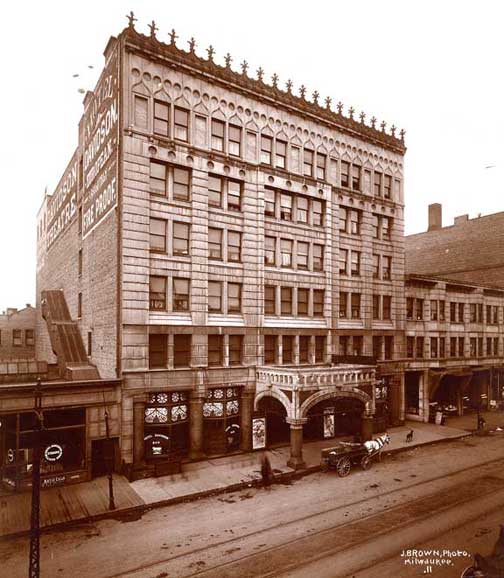
In 1890 John and Alexander Davidson built the Davidson Hotel, located at 621 N. Third Street, in Milwaukee, Wis. Housed within the building was the Davidson theater, whose entrance was through the front of the hotel.
John and Alexander Davidson, wealthy Chicago brothers, built their theatre on land where their father had made a fortune in quarrying. They hired Sherman Brown, a stylish 22-year-old impresario from nearby Oshkosh, as the first manager. Brown, a generous and genial man and an ardent lover of good theatre, remained active for the next 40 years and is still recalled fondly by many old-timers.
“Its theatrical history was interrupted occasionally by films.” In August and September 1898, the Alhambra and the Davidson Theater showed “all the pictures of the late War” (Spanish-American war) projected by “the great biograph.” with “Thrilling Pictures of U.S. Battleship Maine.” War films were popular enough to play concurrently at both theaters. In March 1889, the Davidson Theater also advertised for the “‘FATAL CINEMATOGRAPH’ and its ‘VICTORIOUS ARMIES, NOVEL EFFECTS, BRILLIANT SCENERY and NEWSPAPERDOM!,’” explicitly presenting film as a newspaper-like attraction. The Birth of a Nation was shown at the Davidson in 1915, at prices ranging from a quarter to a dollar.”
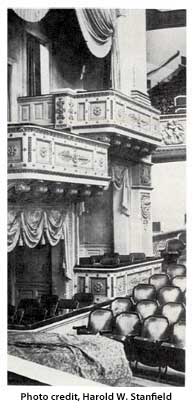
The Davidson Theater’s repertoire was primarily directed toward live theatre pulling in countless stage greats: Sarah Bernhardt, Al Jolson, Eddie Cantor, Irene Dunne, Boris Karloff and Fred Allen. Milwaukee’s own Pat O’Brien played there too, in James Gleason’s stock company. Milwaukee Journal, Remember When.
Live Theater at the Davidson
Among all legitimate houses on the road, Milwaukee’s Davidson was held in peculiar affection by touring theatre folk prior to its closing in 1954. It had a friendly, neighborly atmosphere that pervaded the whole city. It was only a half block from the busiest corner in town, Third Street and Wisconsin Avenue; consequently, dark or not, it was always brightly lighted. Most of the actors’ hotels were within easy walking distance. The union station was only a block and a half from the site, and that made it handy for travelers. Its spaciousness was in the architectural style of the 1890s. Half an acre of lounge and office space extended behind the second floor balcony; the manager had a huge room, which was adjoined by one, equally large, for the press agents and company managers, who had ample space for desk work and for dozing after their labors.
The Davidson’s life span was 63 and half years – some mediocre, but most of them good years, presenting plays, vaudeville, film and musicals. It held the Klaw and Erlanger franchise, which was synonymous with most of the good plays on the road. The Shuberts leased a rival house on the other side of the Milwaukee River, but when hard times compelled the competitors to book cooperatively, the Davidson got almost all the plays. The Theatre Guild, in its lone-wolf role of the 1930s and ‘40s, gave its business to the Pabst Theatre, the traditional home of symphony, opera and German repertory.

“A Night of Splendor” was the Milwaukee Journal headline from the opening night, September 8, 1890. The main speaker at the dedication was Mayor George W. Peck, later the governor of Wisconsin and author of the widely read Peck’s Bad Boy stories. “This building, which has cost a quarter of a million dollars, will endure for ages,” he assured a capacity audience of 1,600. “When Milwaukee shall have acquired a population of a million, let us hope that our great-grandchildren are as enthusiastic friends of this theatre as we are tonight.” But this was a vain, delusive hope since Milwaukee had a long way to go to reach a million and the Davidson would end up a shabby, vacant storefront and a parking lot. Luckily, this could not be foreseen by that first-night throng of Nunnemachers, Auers, Landauers, Pfisters, Vogels, Mitchells (the family of the famed General Billy Mitchell) and so on. The first-night offering was an odd choice: the opera “L’Africaine” presented by the famed Emma Juch and her company. It lasted until after midnight, and many seats were by then unoccupied.
From the start, however, the Davidson got the pick of the world’s theatre luminaries. Modjeska with young Otis Skinner, Salvini, Mansfield, Sothern and Marlowe (who were not then a team), Willie Collier, Sol Smith Russell, Francis Wilson, Bernhardt – what an institution was the road then!
Four years after its opening, the Davidson suffered a disastrous fire that killed nine firemen and injured fifteen. The fire began at 4 a.m., so no patrons were endangered. A troupe of midgets, quartered in an adjoining hotel, was carried to safety by volunteers, one of whom was Charles K. Harris. He was already a widely known songwriter, having brought out “After the Ball” two years previously.
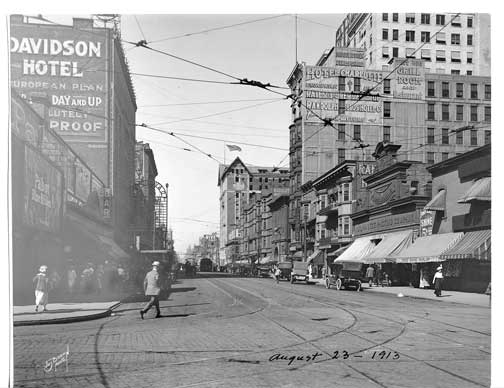
For the next generation, the Davidson’s annals make impressive reading. When the elegant John Drew wowed them in “The Masked Ball,” Maude Adams was playing opposite him. John’s sister, Georgie Drew Barrymore, starred in “Mr. Wilkinson’s Widow,” hardly foreseeing that her three children, Lionel, Ethel and John, would be on that same stage many times in the years ahead. Her husband, Maurice, along with Holbrook Blinn, was only a supporting player to Marie Burroughs in “The Battle of the Strong.” As the 20th century moved along, the Davidson’s stars and dramas formed a galaxy. There were 30 to 40 road shows a year, and a summer-stock company, too. Pauline Lord was a particular favorite of the stock audiences. A glance through the programs reveals William Gillette in “Sherlock Holmes,” Olga Nethersole in the wicked “Sapho,” James (father of Eugene) O’Neill in “The Count of Monte Cristo,” De Wolf Hopper, Ditmar Poppen in “The Student Prince,” Dustin Farnum, the four Cohans, Henry B. Walthall, David Warfield, Minnie Maddern Fiske, and so on, right up to Katharine Hepburn, Melvyn Douglas, Edward G. Robinson and Van Heflin (the latter four returning to the stage from Hollywood). The wheel had come full cycle before the wreckers moved in on March,1954. A department store and hotel firm, which owned the site, found a more profitable use for it. The Davidson’s final attraction was the Canadian National Ballet Company” Theatre Arts (magazine) , April 1958, Famous American Theatres by Walter Monfried, Theatre and Music Editor of the Milwaukee Journal.
The Toy Building (1915 – 1946)
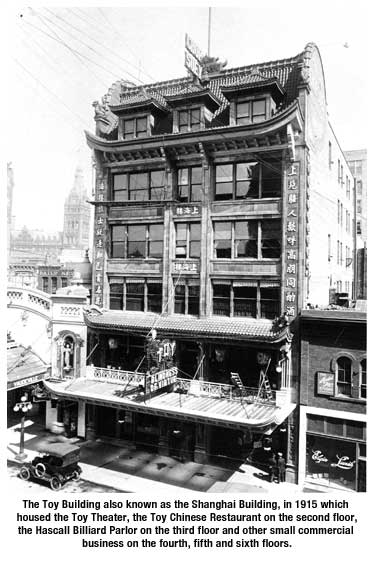
The Toy Building, also known as the Shanghai Building, was located in Milwaukee’s downtown at 736 N. Second St. It housed the Toy (Crystal) Theater, the Toy Chinese Restaurant, the Hascall Billiard Parlor and a few small commercial businesses. Looking at the picture of the front of the building, the Chinese calligraphy written across the building at the forth and fifth floor are ancient Chinese characters which translate saying: Shanghai Building. The entire front of the building was covered with fired ceramic tiles. The roof tiles and overhang tiles were red. The vertical writings on each side are poetic and hard to interpret. Starting at the top of the right side the characters translate as follows: upper garden, writers, celebrity, together. On the other side the characters translate starting at the top: house outside, knowing you better than you know yourself. The characters can have different interpretations. Note the two Chinese dragons at the top of the roof and they also appear on the second floor loggia. The entire design is one reflecting Shanghai, China.
TOY Theater 1915-1924, First Floor
Designed by architect Alexander Guth, the TOY Theatre was a small 460 seat theater on the first floor of the Toy Building. (see theater newspaper ad) In the front of the building a skeleton letter light bulb sign projected from the façade. “Open channel letters, meaning 3-D but open/hollow in front with light bulbs in the letter. Each letter then was mounted on a steel “skeleton” frame/structure, typical of pre-neon (pre 1925) electric signs.” —Tod Swormstedt, American Sign Museum.
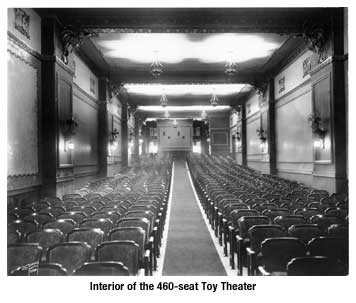
The sign on the top of the roof a sign read “Chop Suey” and the theater sign on the second floor overhang read “Toy.” It had space at the bottom to put in the name of the movie playing at the theater, in this case it was The Blindness of Virtue, based on Cosmo Hamilton’s play of the same name.
This silent, 1915 six-reeled film by the Essanay Film Manufacturing Co., is synopsized thusly: Expelled from college, Archibald Graham (Bryant Washburn) is shipped off to England by his wealthy father, who has arranged that Archie become an apprentice to kindly Reverend Harry Pemberton (Thomas McLarnie). The experience is supposed to “straighten out” the unruly Archie, but the boy is more interested in the local female population than in serving God. Eventually, however, our hero cleans up his act and tries to live his life within the proper moral boundaries. Unfortunately, he is caught in an innocent but compromising situation in a London hotel room, whereupon Rev. Pemberton angrily washes his hands of the boy. But the truth prevails, and in the final scene Archie is shown marching down the aisle with Pemberton’s pretty daughter Edna Mayo. —Hal Erickson, All Movie Guide.
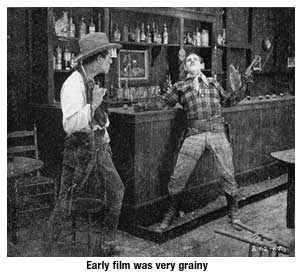
The entry to the theater was under a red tile loggia with upturned eaves projecting from the second story. Brass Oriental lanterns lit the loggia on each side. Copings flanked the steep mansard at the top of the building with terminal dragons in terra-cotta advancing the theme.
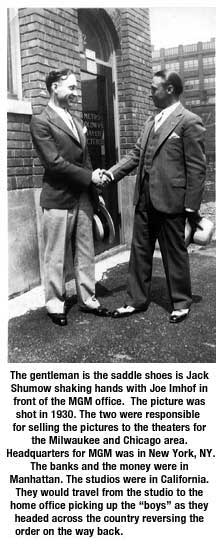
Typical of early movie theaters, the ventilation was almost non-existent. They had a reputation for being hot and stuffy. Note the electric fans along the walls on each side of the theater. The rotating fans were the only ventilation method used to move the air.
Many of the city’s early film exchanges were located in the top three floors of the building. The early movies were often of poor quality – grainy. No one cared. It was new and exciting. Later film exchanges were all clustered in the State Street area. MGM’s (Metro-Goldwin-Mayer) Milwaukee office was located at 832 W. State. All of the major studio’s film distribution offices were located within one block.
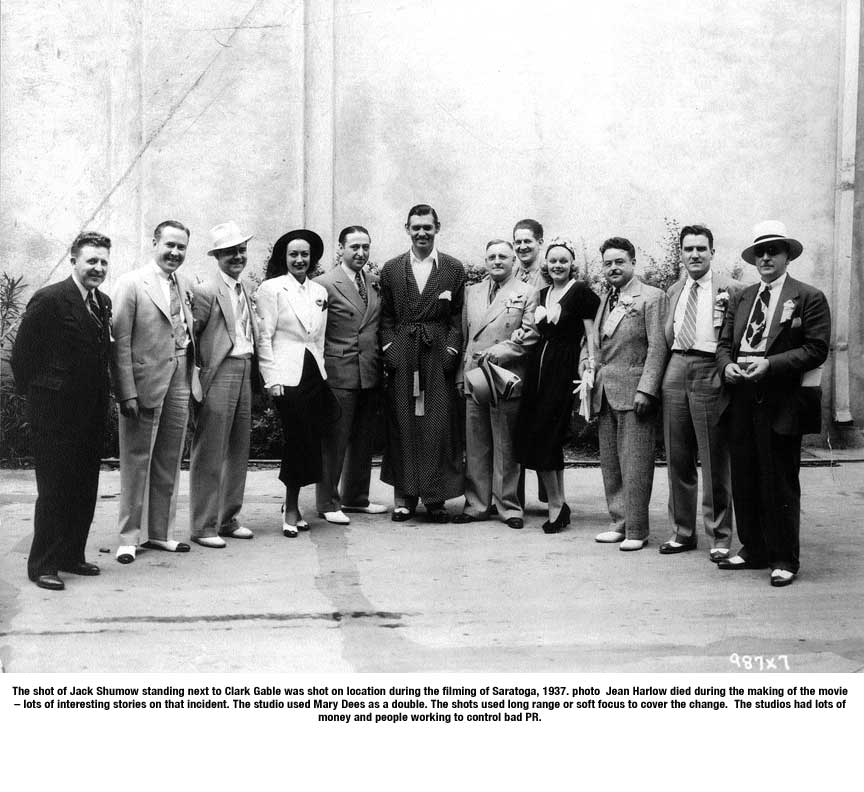
The films came in by train and were picked up by the distribution offices. Movies were shipped in Vitaphone hex-shaped film cases that held 4 to 6 reels. I weighed one of my old Vitaphone 35mm film cases with four reels in it at about 50 lbs. From the film distribution offices the movies were dropped off in the morning in front of the theater or in the lobby. A feature length film would have had six reels. The projectionist had to haul the film cases up four flights of stairs to get to the projection room. After the show ended, the reels were left in front of the theater for pick up the next day. The reels were not re-wound. The film distribution office would re-wind the reels repairing tears, bad splices or missing footage before sending to the next location. Films sometimes did get to the theaters with a bad splice. The projectionist was supposed to inspect each reel before running it. A bad splice hitting the gears could do lots of damage to the projector.

Up until 1960, movies were shown using two projectors. The projectionist (all men) had to make sure that they ran the films in correct reel order. The projectionist started reel #1 on the first projector. About 10 seconds from the end of the reel, a small circle flashed briefly in the corner of the screen. In addition a reel alarm bell started to ring on the top of the projector. This alerted the projectionist to get ready to fire up the other projector. The projectionist fired the second projector up with the next reel just as the other ran out. If the projectionist taking a nap, the screen went bright white when the film ran out. The audience started to yell. Soon the next reel was running. While the second reel was running, the projectionist removed the first reel on the other projector threading the next reel in sequence. In addition the projectionist had to control the house lights and run the 50V 100 amp travel spots if they were running a show. The carbon arc lights used in theaters were always a fire risk.
In 1924 the TOY Theater closed. The population of Milwaukee since 1900 had almost doubled. The new movie palaces coming upon the scene made modest cinemas like this one obsolete. The era of hot stuffy theaters was rapidly being replaced by movie palaces with “water chilled” central ventilators. Without the “theater”, the Toy Building remained on Second St., with the Toy Restaurant as the primary tenant until around 1950.
TOY Restaurant Second Floor, Toy Building
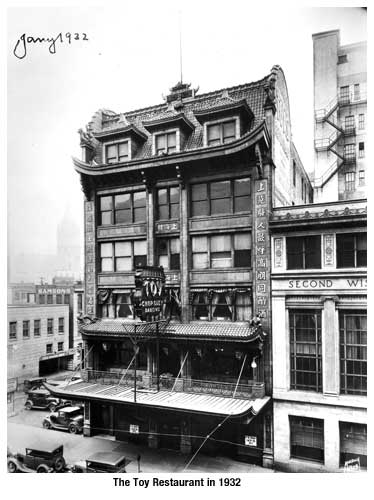
The restaurant was located on the second floor of the Shanghai Building at 736 N. Second Street. The restaurant was the principle tenant in the six story commercial building. Charlie Toy was the entrepreneurial owner who gave his name to the establishment. Toy originally worked for Karl Ratzsch as a waiter before starting his own business here. The restaurant became famous for its Chop Suey among other Chinese menu items. Also contributing to its fame were the dance bands that played there, among them was the Sig Heller band of local notoriety. The Toy restaurant had an unusual façade including large fierce winged dragons all around the top of the dark wood support columns. Dark wood beams ran between the columns. The entrance had a rather wide staircase with a mural of a large dragon that snaked up the staircase as you ascended.
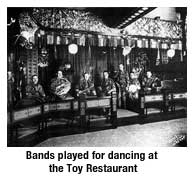
The Toy Restaurant remained in business at the Second Street location until about 1950, when it was relocated at 300 W. Wisconsin Ave., above Walgreen’s, which is the location of the Toy’s Chinatown Restaurant most of us remember. (Walgreen’s was known locally as the 300 club.) Later on in 1968, because of downtown renovation and a new Federal Building slated for its spot, Toy’s Chinatown Restaurant was then moved from its Wisconsin Ave. location to 830 N. Old World Third St. by Moy Toy, the then owner of the business. The Chinese waiters (wearing black) were all men. When taking orders, nothing was written down. Toy’s family was among the first Chinese restaurant owners in Milwaukee. Moy Toy died in 1980, and his son and daughter-in-law, Edward and Laura Toy, took ownership.
Memories of the Toy Restaurant
“I remember that it was a big deal for me when someone’s aunt in my Wauwatosa neighborhood volunteered to take a group of us pre-teen girls to lunch downtown at Toy’s on Wisconsin Avenue above Walgreens. It was a big expedition. We had to take the bus downtown and I was frightened of getting lost in the big city, because I’d only been downtown with my parents a couple of times. I was so frightened that I don’t remember much about the lunch. I was intimidated by the foreignness of it all. Even after Toy’s moved, I remembered that experience every time I saw their sign.” —Donna Pogliano
“Spent my 18th birthday at Toy’s with Bill Schroeder of Schroeder’s Books… had my first Singapore Sling and pressed duck… Toys became a favorite spot… very reasonable. Downtown was full of sailors. The sailors came in on the train from the Great Lakes Naval Base in Waukegan, Ill… came into the Northwest Depot they loved Toy’s.” —Taffnie Bogart
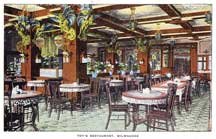
When I was a kid we lived out near Hales Corners, which, after the speedrail (inter-urban light rail) folded in the early 50’s, required an hour’s walk and a good two hours by bus to get into downtown. That meant a trip into town was a major production. Every year at teacher’s convention when we had school off, my Mom would take my brother and I into town to shop, catch a movie, and we always ate at Toy’s, which was really exotic to a kid from the country. My strongest memory was the incredible dragon that was painted on the wall of the staircase that led from the street to the second floor. To a kid it was the biggest, most colorful thing he had even seen – and when I found out my last name was derived from “draco” (the constellation of the dragon), I forever became a fan of the exotic and of adventure.” —David HB Drake
Hascall Billiard Parlor, TOY Building, Third Floor
Looking carefully at the front of the building, each window on the third floor had either HASCALL or BILLIARDS lettered on it. This floor housed the Hascall Billiard Parlor. Billiards were a popular pastime in those days and it wasn’t hard to find a billiard parlor not too far from wherever people congregated. Note that the billiard table did not have pockets. Billiards or three cushion is played with two white balls one of which has a black dot. In addition a red ball is on the table. Each player has a white ball. The object is to hit three cushions plus one of the other balls (after the last cushion). The ball can have “English” (spin) put on it by hitting the ball slightly off center with the cue stick. The spin affects the bounce off the cushion. Trying to figure out the angles and the “English” needed is a high skill game once popular. Billiards was a game played by gentleman. Pool was quite a different story.
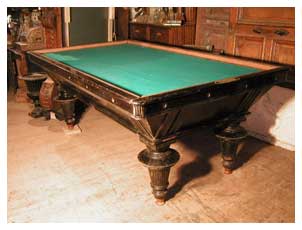
“Well, either you’re closing your eyes to a situation you do now wish to acknowledge, or you are not aware of the caliber of disaster indicated by the presence of a pool table in your community. Ya got trouble, my friend, right here, I say, trouble right here in River City. Why sure I’m a billiard player, certainly mighty proud I say, I’m always mighty proud to say it. I consider that the hours I spend with a cue in my hand are golden. Help you cultivate horse sense and a cool head and a keen eye. Never take and try to give an iron-clad leave to yourself from a three-rail billiard shot? But just as I say, it takes judgment, brains, and maturity to score In a balkline game, I say that any boob kin take and shove a ball in a pocket.” — The Music Man
Commentary: “The Toy Building was razed in 1946” — Veronica Takahashi
